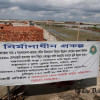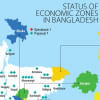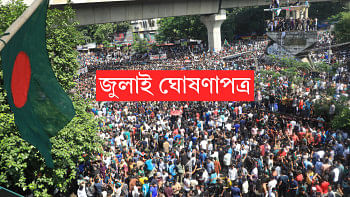New land raises new hope

Bangladesh has acquired several thousand square kilometres of new land over the last four decades, owing largely to deltas forming on major rivers and in the coastal areas.
This has been a blessing for the small country where usable land is shrinking every year because of natural and man-made causes. Already, the government has taken up some projects like building economic zones on the new land.
Less erosion and more accretion of rivers gave Bangladesh the land, and new pieces of land are emerging every year mostly in Chittagong, Noakhali, Cox's Bazar, Patuakhali, Feni and Bhola.
Analysing satellite images last year, the research team of the Centre for Environment and Geographical Information Services (CEGIS) found 40 new chars, of about 1,643 sqkm, in the Meghna estuary alone, formed over the past 15 years.
The team also spotted around 75 emerging chars (now about 221 sqkm). But CEGIS Director Mohammed Shahidul Islam said they might disappear due to erosion.
“The government has taken a number of initiatives to set up special economic zones on some new chars in Feni, Chittagong and Cox's Bazar. Work on land development is going on in Mirsarai and Feni,” Paban Chowdhury, chairman of Bangladesh Economic Zones Authorities (BEZA), told The Daily Star.
On some of the land, the forest department has undertaken afforestation programmes to protect them from erosion.
LAND RESOURCE
The area of Bangladesh is 1,47,570 sqkm -- 1,33,910 sqkm land and the rest 13,660 sqkm water bodies, according to government figures.
The per capita land in Bangladesh is only 24 decimals while the quantity of agricultural land is even less -- 14 decimals, one of the lowest in the world, according to the annual report (2014-15) of the land ministry.
Every day, an estimated 220 hectares of land is converted for commercial uses. If the trend continues, the per capita agricultural land would reduce to only six decimals by 2050, the report warns.
In 2008, a CEGIS study found that Bangladesh gained 597 sqkm of new land between 1973 and 2008. During the period 1,642 sqkm of new land formed while 1,045 sqkm was lost in erosion.
Later in 2013, Bangladesh Soil Research Development Institute in a report titled “Agricultural Land Availability in Bangladesh” stated that 5,47,128 hectares (5,471 sqkm) of new land emerged until 2010 since independence in riverine areas alone.
The report mentioned that char formation intensified between 2000 and 2010.
Towards the beginning of this millennium, Subarnachar and Nijhum Dwip of Hatia have virtually connected with the mainland due to char formation. Several other islands, including Char Kabira, Char Alim, Sagaria, Uchkhali, New Dalchar and Keringchar also developed around Noakhali.
The government has taken an initiative to build a cross dam at Urirchar, which would connect Sandwip island with the mainland. This may lead to the emergence of more chars.
All this, however, will not change the official land area of the country because these chars are emerging out of the already calculated 1,47,570 sqkm area. But it will change the ratio of land area and water bodies, said Md Fayekuzzaman, acting director general of the land survey and record directorate.
“We cannot say exactly how much land has emerged, but we have been continuously working to record the new pieces of land. Currently, our team is working in Jamalpur, Patuakhali, and Maheshkhali of Cox's Bazar,” he added.
Amir Hossain Chowdhury, divisional forest officer of Noakhali, said they had a target to plant trees on 19,000 hectares of coastal land in the next five years.
“The soil is not hard yet. The trees will eventually make the newly emerged land hard,” he added.
SPECIAL EPZ
On the newly emerged land in Sonagazi of Feni, the government has been setting up one of the biggest special economic zones.
Development work on 700 acres of land is on and by next year, the BEZA expects to develop around 7,500 acres of land there.
The BEZA chairman said some 633 metres of new land emerged in the coastal area of Sonagazi each year.
Generally whenever a char emerges, people go there to start cultivation. Sometimes they get allocation from the district administration. So the government has taken up a policy to develop economic zones in the newly emerged land so that it does not have to pay compensation to land owners.
The government has undertaken a mega development project also in the coastal area of Cox's Bazar.
These projects will be implemented on 35,000 acres of land in Maheshkhali, Pekua, Ukhia, Teknaf and Kutubdia.
The BEZA plans to set up 10 special economic zones on 15,000 acres of land in Teknaf, Maheshkhali and Cox's Bazar Sadar upazilas.
“The land ministry has already approved some of these projects,” said Ali Hossain, deputy commissioner of Cox's Bazar.
[Our Cox's Bazar correspondent Mohammad Ali Jinnat contributed to this report.]

 For all latest news, follow The Daily Star's Google News channel.
For all latest news, follow The Daily Star's Google News channel. 








Comments